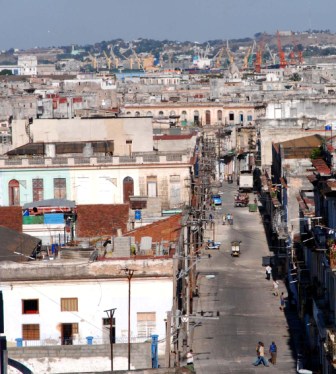Havana-Miami: Mr. Hyde & Dr. Jekyll (2)
By Alfredo Prieto*

HAVANA TIMES, May 18 – In one of his works, sociologist Lisandro Perez refers to a fact about which I want to pursue in these reflections. At the end of the 19th century, during an immigration hearing held in Key West (which ever since Cubans have called Cayo Hueso), a US citizen took the stand and said something more or less like this: “You have to understand that when people say ‘let’s go to the Key’, they do so as if saying ‘Let’s go to Nuevitas, Colon,’ or some other place on the island.
It is true that Key West is in some way a special place. It’s the closest point of the United States to the island and its streets, buildings, docks and facilities all have names with a Cuban stamp. But I suspect that something similar occurs between Havana and Miami, two cities interconnected by various and mutual flows, although separated by their own asymmetries that mark the difference between the First and the Third World.
This also happens with San Diego and Tijuana, and with any of the places located along the thousands of miles of border between the United States and Mexico, a fact that experts refer to as “border porosity.”
For many Cubans, Miami is the second city. Located only 288 kilometers from the capital, its proximity is a sensorial fact. You can board an airplane having washed your hair at Jose Marti International Airport and arrive there with your locks smelling shampoo fresh-the trip takes only 45 minutes. In contrast, traveling to other cities on the island, such as those in the eastern provinces, takes almost two hours to get there.
The historical flow of the population, in addition to recent migration, has generated a network of family relationships increasingly perceived as normal since the end of the 1970s. This was when the Cuban government began allowing visits for the first time by those who had left, though under the condition that they could not involve themselves in activities directed against the Revolution.
.jpg)
That “logic of contact”–affected but by no means eliminated by the measures of the Bush administration in June 2004, and now being reversed under Obama–reinforces a group of earlier ideas among Cubans on the island. Among them one that stands out is what I call “the mirage”; that is to say, to assume that those in Miami automatically have everything lacking here in terms of material possessions by the mere fact of crossing the Strait.
What is produced is an idealization of life on the other side, a kind of abrupt swing of the pendulum, especially among youth. You “read” that nothing can be worse than Cuban day-to-day life in times of crisis.
This frequently creates feelings of frustration within those who have recently arrived, as the documentary Balseros (rafters) depicts. It is harrowing to face the complexities of concrete life in the United States, where the only thing that counts is strict individual initiative-a notion they are not used to given the “birth rights” guaranteed by the Cuban State.
However, this is something that the new emigration is altering on Miami’s ideo-political map; the newly arrived are bringing these expectations with them, as if they were recorded onto their hard drives.
Miami is otherwise the place where one can live a Cuban lifestyle and acclimate without great difficulties due to the existence of this enclave, initial family support and the fact that one does not need to master English before or after coming. These are facts that can be confirmed, frighteningly, in Samuel P. Huntington’s book Who Are We: The Challenges to America´s National Identity (2004), in his anti-Hispanic crusade.
Seen from the island, “to live Cuban” in Miami means roasted pork and beefsteak with French-fries at the La Carretta diner, freshly brewed Cuban coffee on some corner in Little Havana, dominos, Santeria, the photo of the latest model car in front of your house and the colloquial programming on Channel 41.
Likewise, it’s the music of Celia Cruz, Willy Chirino and others salseros, Cuban actors who have moved there in the last few years, as well as Guillermo Alvarez Guedes’s jokes, and information that comes from Cuba through a variety of informal channels, in addition to contact.

Having made the decision to emigrate, all one needs to get to the “other Cuba” is a visa, then to cross the US-Mexican border. Alternately, they can take the more dangerous and irrational route: jump in the water, despite the fact that with the 1994 immigration agreements the entry ofbalseros (rafters) rescued in the strait is no longer automatic and many are returned to Cuba.
The wet-foot/dry-foot policy, adopted in that context, is one of the bases of human trafficking and the explanation for why the entry door to the US has shifted to the Mexican path.
Then there are those who do not want to emigrate -who enjoy visits, money and gifts-, and usually harbor feelings of reservation toward the others, at least in certain public aspects.
The main one is the reticence about Miami Cubans at some time investing in the island, given islanders’ comparative disadvantages and their perception of the subordination that this would imply. A writer from the island recounted to me that one time, during a visit to Miami, an old friend from a private school where they had both studied told him: “Someday you’ll work for me.” His response was: “You don’t know how much I thank you for telling me that.”
This is the face of Dr. Jekyll, even though suspicion and other reservations remain.
*Alfredo Prieto is a Cuban essayist and editor. He lives in Havana.






I lived in Cuba and faced the embargo and the difficulties associated with it. This included companies outside the USA refusing to do business with Cuba for fear of damaging their trade with the USA.
CubaJournal,
I live in Havana and every time I go back to Miami I can’t believe it. It’s so sad how crumbling and decrepit and poor this country is and what Cuba could potentially be if only the communist government would allow the Cuban people to excercise their own initiatives in order to improve their lives.
And you want to talk about racism? Why don’t you talk to the Cuban National Police here in Havana who frequently accost and shake down Cubans based solely on the color of their skin.
The fact is, Cubans in general tend to be somewhat obsessed with skin color. And that takes place whether you’re in La Habana or Magic City.
Miami is not Cuba. It is what the Yankee imperialists would like Cuba to be. Miami is full of capitalist crimes and corruption. Miami is a highly racist society. Cuba would never re-import that kind of a society.